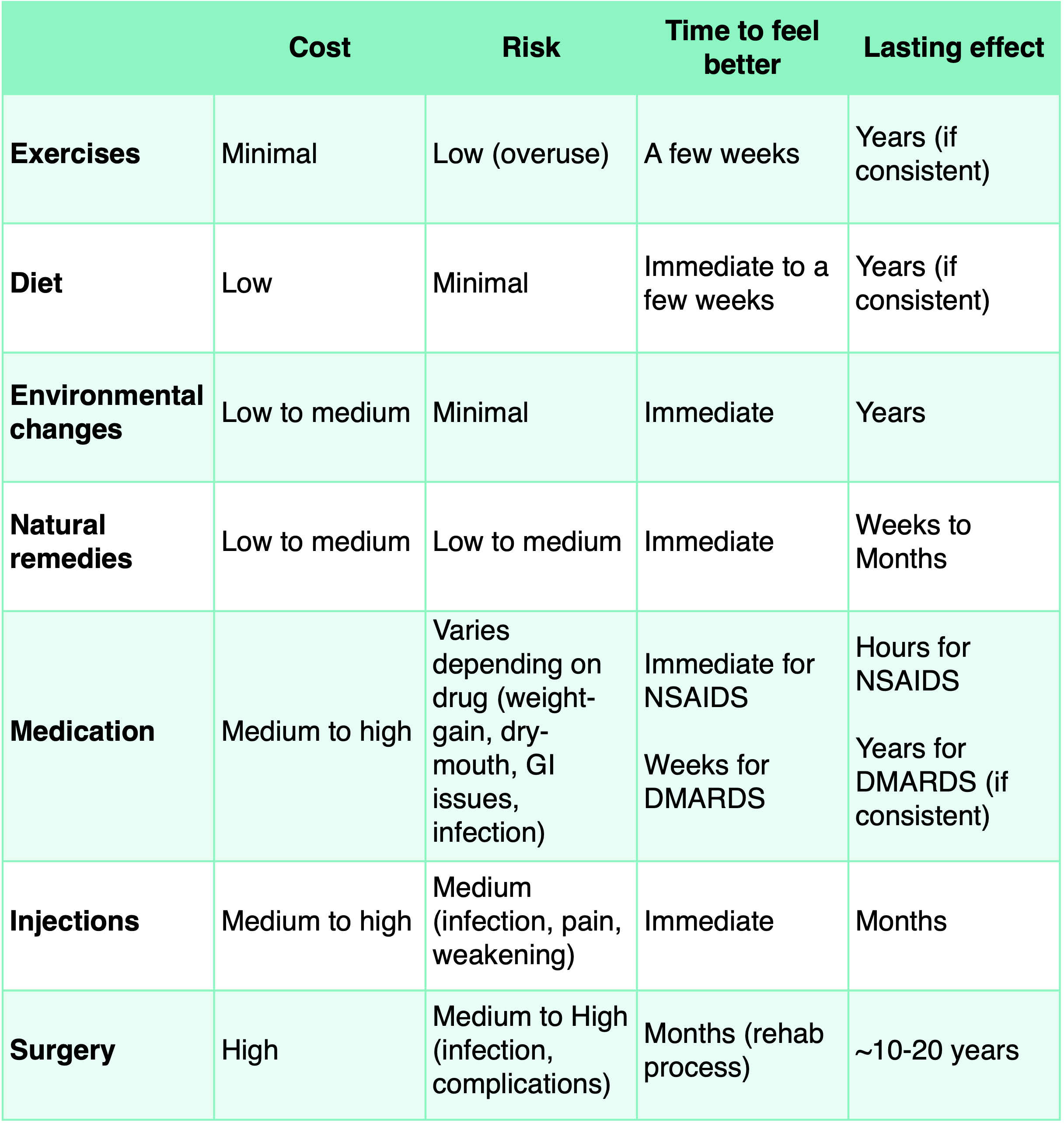
When you have arthritis you may feel overwhelmed with the treatment options for pain relief. Here is an overview of your options, where we try to help you weigh the pros and cons of different treatments.
There are four main criteria that may help you make a decision:
- Cost
- Risks
- Time to feel better
- Lasting effect
And remember, these options are not mutually exclusive. You need to find the combination of options that works best for you, but it’s unlikely that a single option will be a silver bullet.
Let’s cover each option. You can skip to:
Exercises
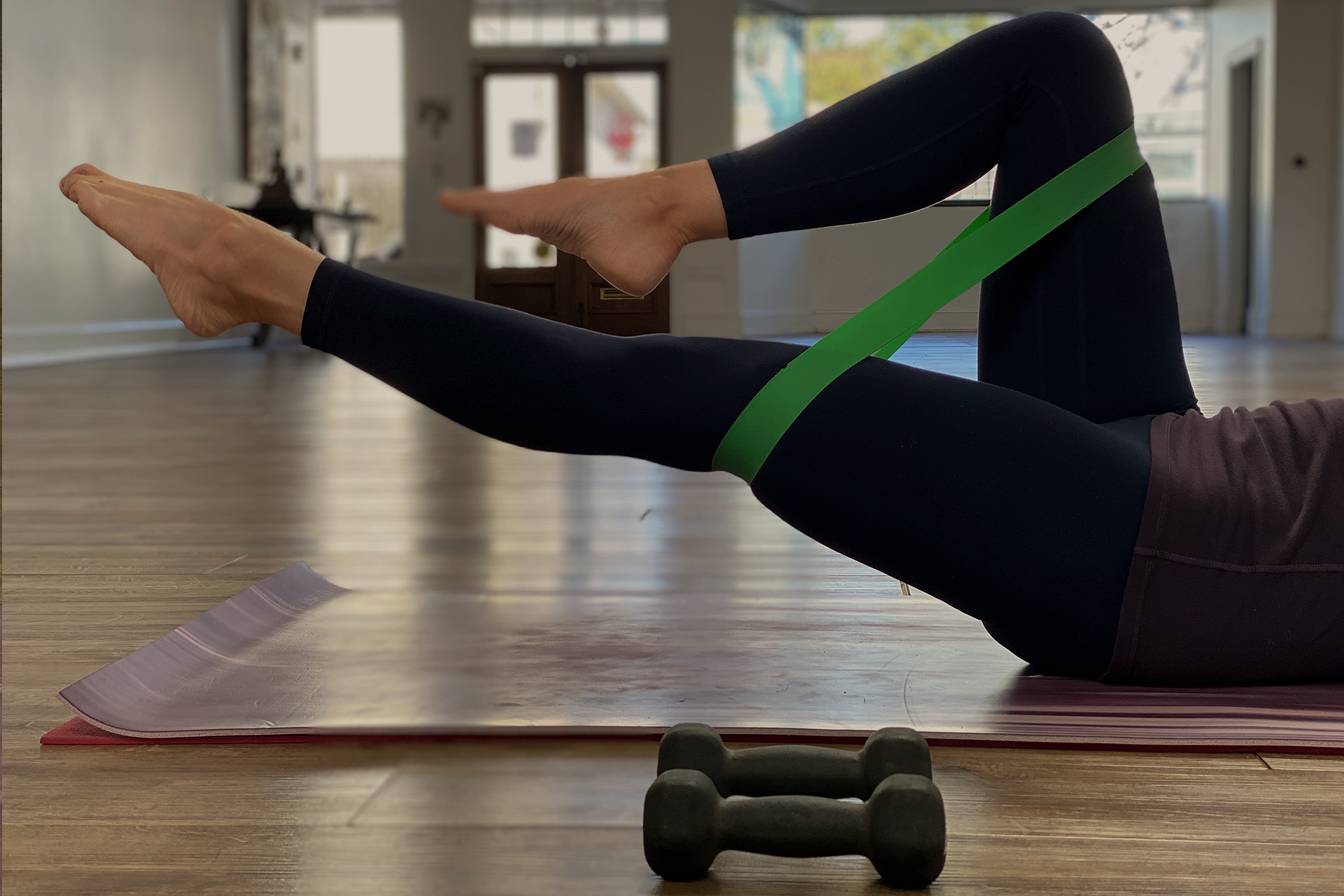
If you have arthritis, exercise can help relieve the pain. Exercises help to build muscle around the joints, reduce the stiffness, and keep the joints moving. Exercises and physical activity not only can help with improving the function of your joints, it releases endorphins or the “happy hormones” that can improve your mood.
Cost: Minimal
Exercise cost can range greatly from free to hundreds of dollars. You can keep cost low by using free activities like walking and body weight exercises. Cost can increase with equipment, classes, and professional training.
Risks: Low
The risk of exercising is overuse or doing an exercise that your body is not ready to do. There is potential you may injure your tendons or muscles if you are doing an exercise that is too challenging for you. It’s always best to ease into an exercise program and consult with your physician, therapist or trainer before starting something new.
Time to feel better: A few weeks
With exercising you can see positive effects immediately including less stiffness, decreased pain, and improved mood.
Lasting effect: Years
The long term effects of exercise, such as building muscle mass or improving cardiovascular endurance, take weeks or months. In particular, increasing your muscle mass may reduce stress through the arthritic joint. And as long as you keep up with it, the effects are everlasting.
Regardless of the type of arthritis or where you are at in your arthritis journey, exercise is a good place to start to find arthritis pain relief. If you are not up to exercising just yet, small bouts of physical activity have benefits.
One place to start is to try to minimize the amount of time you are in one position. For example, if you sit to work, add in a short walk around your office, or around the block to break up the time you are sitting.
If you need inspiration for exercise to relieve pain, see our 7 daily hand exercises for arthritis, for exercises to work the hand. We also frequently post exercises on our Instagram page.
Anti-Inflammatory Diet

Inflammation is a natural body response that generally occurs when there is an injury or infection. In those cases, inflammation is necessary to fight the “bad cells”. However, inflammation from diet is a process called diet-induced oxidized stress. In this case, our diet leads to an imbalance between free radicals and antioxidants. Over time, the surplus of free radicals may lead to a state of chronic inflammation.
To break the chronic inflammatory cycle, we need to include more foods that do not produce an inflammatory response. These types of foods are rich in nutrients and minerals and help your body balance the free radicals.
Anti-inflammatory foods include berries, vegetables like broccoli and kale, beans, nuts and seeds, and more!
Cost: Minimal
The cost of incorporating an anti-inflammatory diet is minimal and can be incorporated by just a few swaps at the grocery store and throughout your day.
Risks: Minimal
There are minimal risks with adopting an inflammatory diet. But, always consult with a professional to make sure that this option is the right one for you, and to keep a balanced diet.
Time to Feel Better: Immediate to a few weeks
If you are incorporating an anti-inflammatory diet, you might not notice changes in your inflammation or pain immediately. It may take weeks of consistently incorporating these changes to see a benefit.
Lasting Effects: Years, if consistent
Since an anti-inflammatory diet can prevent further joint damage and chronic inflammation, the effects can last forever.
Environmental Changes
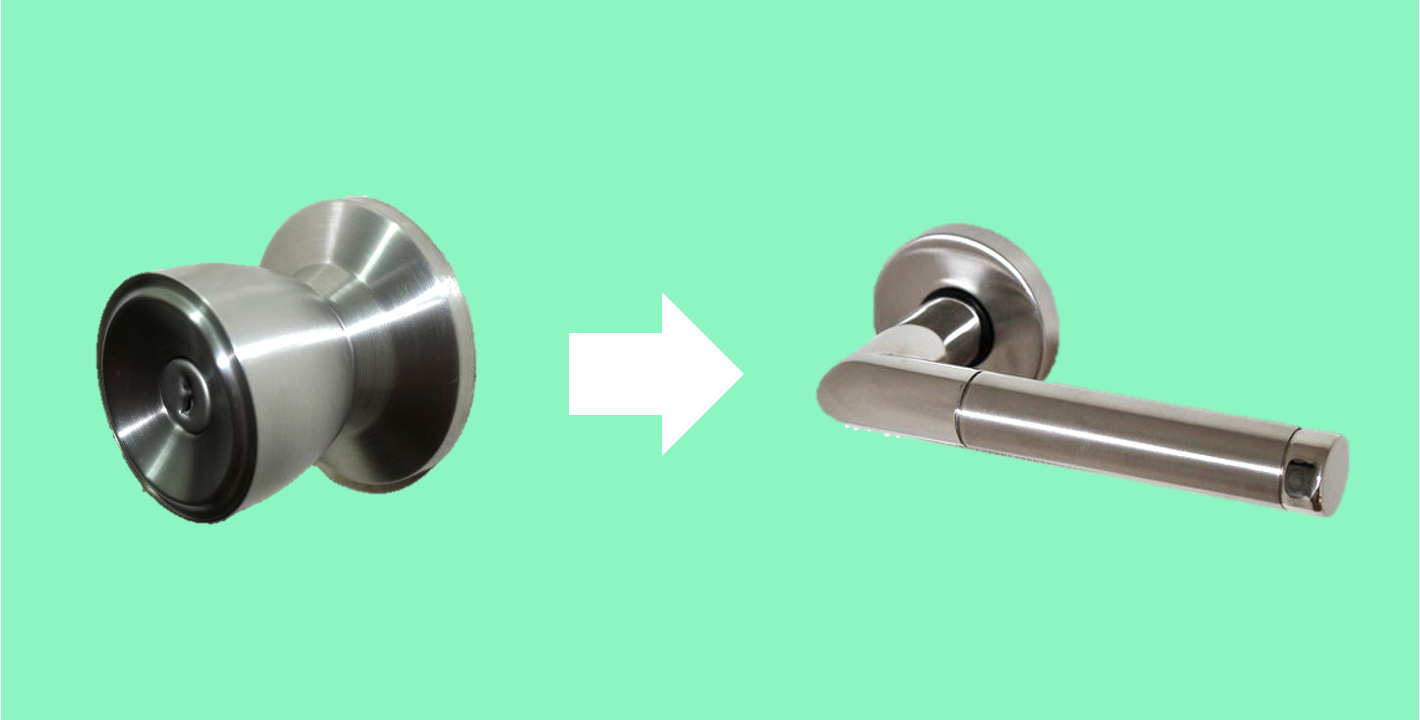
One way to relieve pain with arthritis is to adapt your environment to simplify daily tasks, especially if your arthritis affects your hands. The joints in the hand are tiny and compact, making the joints susceptible to arthritis pain.
As we go about our daily activities the way we pickup, hold, and interact with objects in our environment can add stress to our joints. To reduce the stress, you need to reduce the force placed through the joints.
One way to do this is by using the larger muscles of the body rather than the small muscles. For example, when carrying an object like a laundry basket, keep both palms up and underneath the basket rather than lifting it with your fingertips. This puts the stress of the load through the larger muscles of the upper arm than the tiny muscles and joints in the hand and fingers.
Another option is to adapt your existing environment. This would include things like changing the handles you have in your home and opting for a lever handle rather than a door knob.
Other things could include adding built up foam to handles, using an electric jar opener, and using a non-slip mat in the kitchen.
Cost: Low to Medium
The costs of making these changes vary depending on how many adaptive gadgets you purchase and if you opt for bigger changes. In general, changes can be done in an affordable way.
Risks: Minimal
There are minimal risks associated with making environmental modifications.
Time to Feel Better: Immediate
You may notice the effects right away when completing a household task. For example, using the non-skid mat while opening a jar, you may immediately feel less pain. Over time, incorporating these modifications can prevent further joint damage and decrease overall pain.
Lasting Effects: Years
Making these small but impactful changes can minimize the damage done to the joints and improve the healthy joint’s longevity.
Natural Remedies
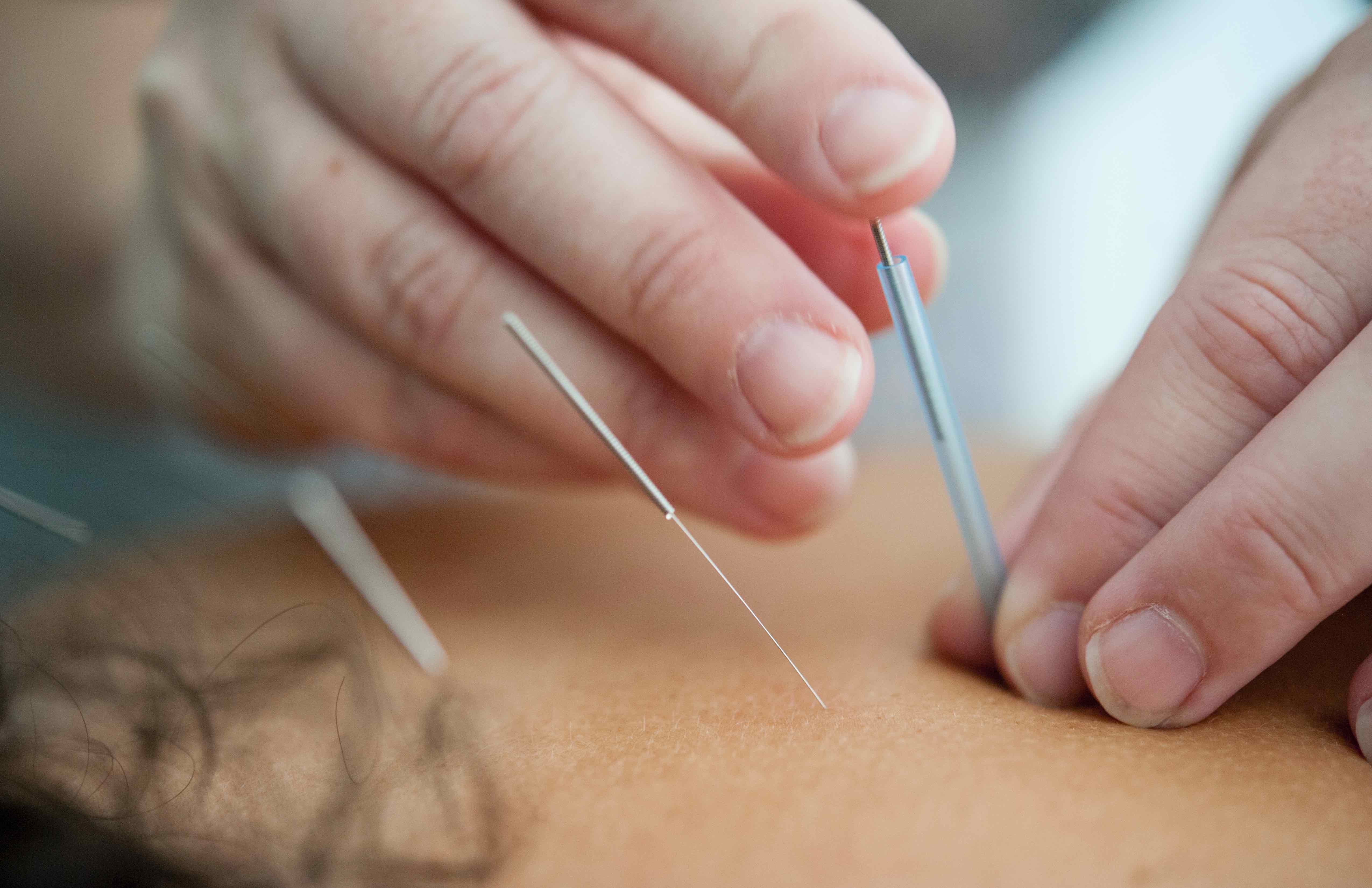
THERMAL MODALITIES
Heat and Ice are thermal modalities that can both be used to relieve arthritis pain, though they work in different ways.
Ice works best 24-48 hours after an acute inflammation and can be an option to reduce pain. Cold modalities constrict the blood vessels to reduce blood flow to an area of the body, and this helps to reduce inflammation.
Heat is best used to reduce stiffness in the joints. Heat helps increase circulation, relax the muscles and reduce pain. It can take the form of hot packs, warm compresses, warm water soaks, or paraffin wax.
ACUPUNCTURE
Acupuncture is a component of traditional Chinese medicine that uses the insertions of very thin needles at strategic parts around the body to relieve pain, tension, and stress.
According to Chinese medicine, there are over 2,000 acupuncture points within the body that create a pathway for energy. If the energy, known as Qi, in the pathway is disrupted, it is believed to cause disease and pain. The acupuncture needles are believed to help improve energy flow in the pathway and to improve overall health in the body.
In Western medicine, the needles are believed to stimulate the nerves, muscles, and tissue to increase the production of endorphins, or natural pain killers in the body.
Cost: Low to Medium
Thermal modalities are generally affordable, and you can always opt for the most cost-effective solutions: ice and warm water.
Acupuncture may be covered by your insurance provider, so cost may vary. According to GoodRx, the average cost of an initial session is $112 without insurance. You may require additional sessions so cost may be higher.
Risks: Low to Medium
Thermal modalities may affect the skin and can cause burns or skin damage, especially if not applied correctly.
The risks for acupuncture are generally low as long as the procedure is performed by a certified professional and with single-use needles. Minor risks include sore muscles and bruising. A more severe risk is bleeding, especially if you have a bleeding disorder.
Time to Feel Better: Immediate
Thermal modalities can work right away and you can feel better after a quick 10-15 minute application.
You may feel relief immediately after the acupuncture procedure and the relief can last for days and weeks depending on severity of pain to start. But, you may require several sessions before you see relief.
Lasting Effects: Weeks to Months
Thermal modalities can work to take the pain away for a short amount of time but, when used on their own, you will not experience a lasting effect on the pain. However, you may use them on a regular basis, and it can be a good tool to manage the pain.
With acupuncture, some people feel that the pain is relieved completely. Others, have said it lasts a shorter amount of time like weeks to months.
Medication

There are a number of different medications that your physician may prescribe you if you are diagnosed with arthritis. We’ve laid out a few of the more commonly recommended or prescribed medications for arthritis.
NSAIDs
Non-steroid anti-inflammatory drugs are a large classification of drugs that relieve both inflammation and pain. They work by reducing the production of the body’s chemicals, called prostaglandins, by blocking the enzyme, cyclooxygenase. The reduction in prostaglandins, reduces inflammation, fever and pain.
NSAIDs in arthritis can help to temporarily relieve that pain and inflammation in the body. Common NSAIDs include:
- Ibuprofen
- Naproxen
- Diclofenac
DMARDs
Disease modifying anti-rheumatic drugs or DMARDs are drugs prescribed by physicians, often rheumatologists, that work to suppress the inflammatory response in the body. Typically they are prescribed to people with rheumatoid arthritis but can also be used for people with other types of arthritis like psoriatic arthritis, systemic lupus erythematosus, or ankylosing spondylitis.
There are different types of DMARDs that need to be discussed with your physician to determine which one is the best for you.
Determining which medication will be best is determined by a number of factors including how long you’ve been experiencing symptoms, the stage and severity of the condition, the possible risks and side-effects, and personal preference.
Common DMARDs include
- Methotrexate
- Sulfasalazine
- Hydroxychloroquine
- Leflunomide
- Azathioprine
TOPICALS
Topical medications like gels, creams, and patches are applied directly to the skin. Sodium channel blockers like lidocaine or prilocaine work by blocking the nerve ending channel that is close to the skin. Topical NSAIDs work by reducing the cellular inflammatory response within the joint space.
Cost: Varies
Over the counter medications like most NSAIDs and topicals are generally much cheaper than prescribed drugs and you can find them at your local drug-store.
DMARDs cost will vary on your insurance coverage. But in general they are very costly and can cost a patient thousands of dollars each year, even with insurance coverage.
Risk: Varies, but often risk of side effects
Like any medication there are risks associated with use. Specific risks will vary based on the medication but range from weight-gain, dry-mouth, GI issues, stomach ulcers, infection, and more.
Time to Feel Better: Immediate (NSAIDS) to Weeks (DMARDS)
For drugs like NSAIDs and topicals, you may see relief immediately.
DMARDs take weeks or even months to notice a change.
Lasting Effects: Varies on Medication
With NSAIDs relief typically lasts a few hours. Since they are not altering the disease process, the pain relief is temporary and best used during an acute pain flare up.
DMARDs, when taken consistently, can greatly alter the disease process, decreasing the damage to the joints and have effects that last years.
Cortisone Injections

Cortisone injections are widely used to relieve arthritis pain and are often used to reduce inflammation within the joint. They typically work by injecting a corticosteroid and local anesthetic into the joint. The corticosteroid, helps to reduce inflammation in and around the joint.
Cost: Low to Medium
Out-of-pocket cost for an injection varies based on insurance coverage. Typically, insurance will cover at least some of the cost if you have explored other conservative measures like Physical Therapy first.
Risk: Medium
Much like any procedure or medication, cortisone injections come with risks. There are risks with injections for infection, increased pain, and weakening of the cartilage.
Time to Feel Better: Immediate
Some patients feel better within a few hours after receiving the injection in the joint after the initially swelling and inflammation goes down.
Lasting Effects: Months
The pain relief effects of the cortisone shot may last up to several months.
Most surgeons will only do 2-4 injections in a single joint due to risk of damaging the cartilage, so injections are not a long term solution but may relieve some arthritis pain in the short-term.
Surgery
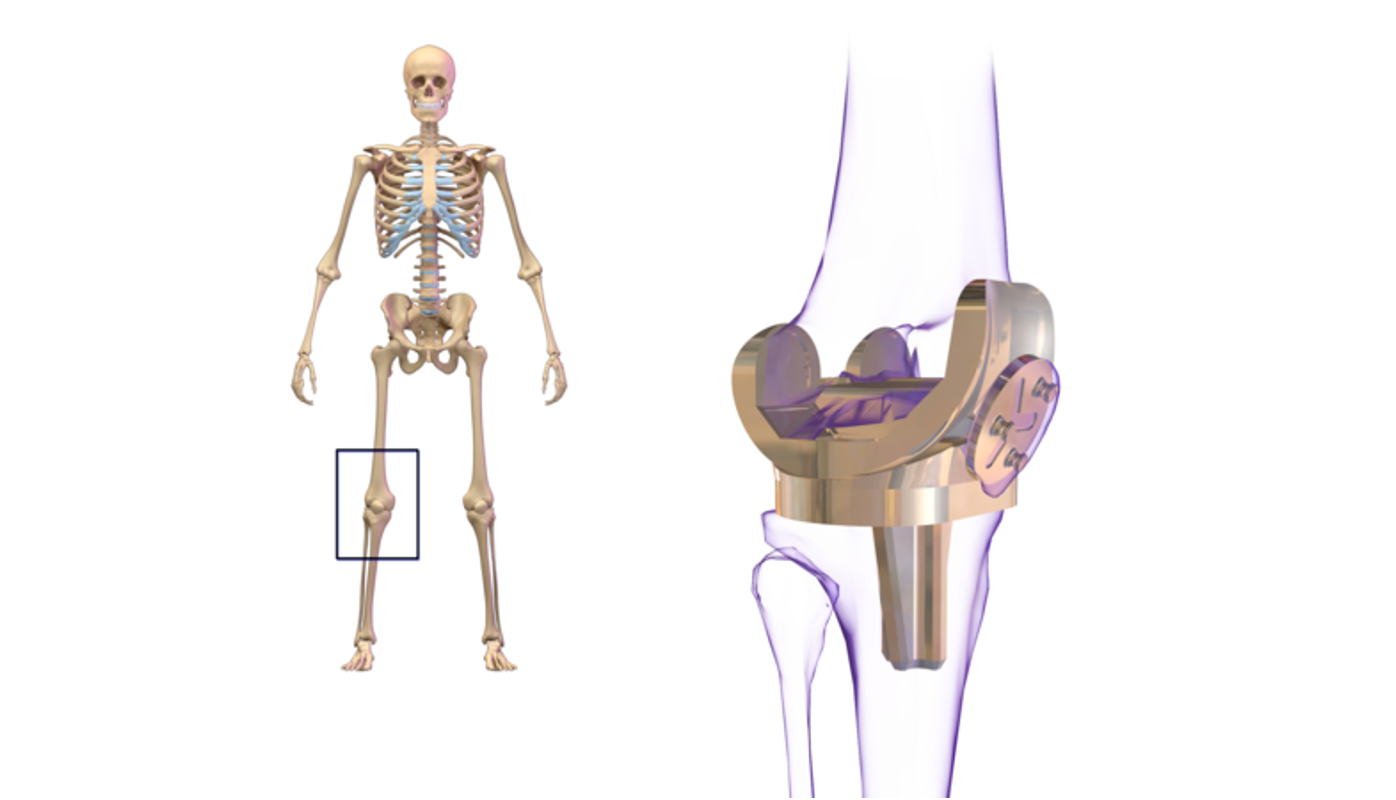
Surgery for arthritis may be an option to relieve your arthritis pain. Depending on which joint the arthritis affects and the type of arthritis you have, your options for surgery vary.
Arthritis can cause serious damage to your joint. Surgery will remove the affected part or replace the affected joint, and improve the way the joint functions.
Here are some of the most common types of arthritis surgeries:
- Synovectomy– Removal of the inflamed synovium, the lining tissue around the joints. Typically performed for people with chronic inflammatory arthritis like rheumatoid arthritis.
- Joint Resurfacing– Replacement of a part of the damaged joint. Typically performed for hip and knee joints.
- Osteotomy– Cuts and a piece of the bone to help shift weight away from the damaged side of the joint.
- Arthrodesis– Means joint fusion of two bones together. Often completed for someone with severe osteoarthritis or rheumatoid arthritis. Fusions can limit joint mobility and change the body’s biomechanics but also can improve the joint’s strength.
- Total Joint Replacement– All or parts of an arthritic joint are removed and replaced with a prosthesis to replicate the movement of a healthy joint.
Cost: High
Surgery in America is costly. In one estimate by Blue Cross Blue Shield in 2019, the cost of a knee replacement surgery was $30,249 for an inpatient surgery and $19,004 in an outpatient setting. Some factors that will contribute to the cost are how many days you spend in the hospital, type of surgery, physical therapy, pre-op and post-op labs, and insurance coverage.
Risk: Medium to High
There are risks for infection, adverse reactions like blood clots and complications with anesthesia, and continued pain after surgery. Other risks include failed surgery, decreased range of motion, and increased pressure on surrounding joints and tissues.
Remember to always consult with your surgeon to discuss your specific risks and benefits of surgery.
Time to Feel Better: Months
Depending on the surgery, your recovery time will vary but ranges from days to month. You may feel better right after the surgery once the swelling goes down. Or you may not feel better for months if you have a longer recovery time and require therapy to rehab your joint.
In some estimates, 9 out of 10 people after a knee replacement (total knee arthroplasty) experience an increased quality of life. But, that does not come all at once. Typically, it takes about 3 months to get back to most activities and 6 months to regain the strength lost from surgery.
Lasting Effects: Years (~10-20)
Typical estimates for a joint replacement surgery are around 10-20 years before needing a revision. But, with medical technology constantly improving, it is difficult to accurately predict how long a joint replacement will last.
With other surgeries, like a synovectomy the pain relief may be forever because the surgery is removing the inflamed synovium, which is often the pain causing part.
Would you like to try some of these solutions to relieve arthritis pain? Speak with your doctor today and see what combination of options might work best for you.
Reactiv may also be able to help! Reactiv connects you with a joint specialist who designs a care plan for you and guides you through engaging exercising games. Reactiv is in network with select health plans. Sign up to see if Reactiv is a good fit for you.
Disclaimer: This post is for general informational purposes only. It should not be used to self-diagnose and it is not a substitute for a medical exam, cure, treatment, diagnosis, and prescription or recommendation. You should not make any change in your health regimen, exercise regimen, or diet before first consulting a physician and obtaining a medical exam, diagnosis, and recommendation. Reactiv Inc. is not liable or responsible for any advice, course of treatment, diagnosis or any conclusions drawn, services or product you obtain through this post, video, infographic, table, photos, or site.
